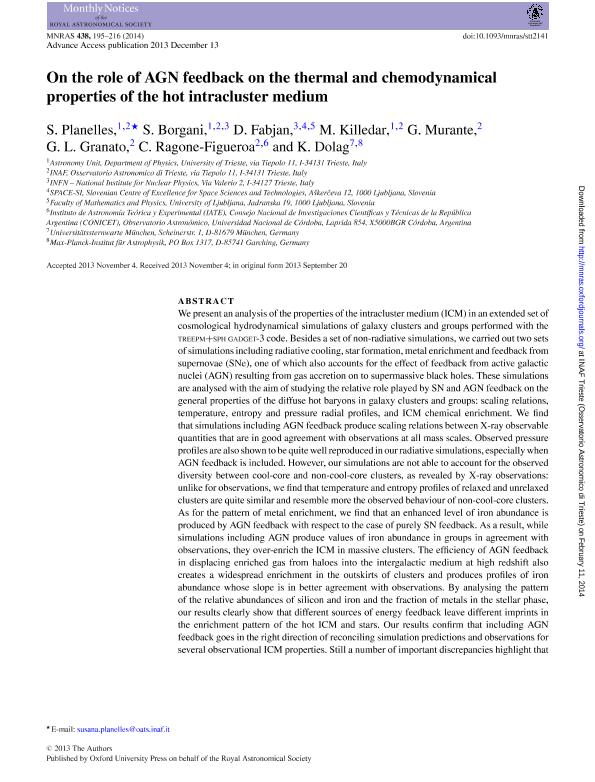Artículo
On the role of AGN feedback on the thermal and chemodynamical properties of the hot intracluster medium
Planelles, Susana; Borgani, Stefano; Fabjan, Dunja; Killedar, Madhura; Murante, Giuseppe; Granato, Gian Luigi; Ragone Figueroa, Cinthia Judith ; Dolag, Klaus
; Dolag, Klaus
 ; Dolag, Klaus
; Dolag, Klaus
Fecha de publicación:
01/2014
Editorial:
Wiley Blackwell Publishing, Inc
Revista:
Monthly Notices of the Royal Astronomical Society
ISSN:
0035-8711
e-ISSN:
1365-2966
Idioma:
Inglés
Tipo de recurso:
Artículo publicado
Clasificación temática:
Resumen
We present an analysis of the properties of the intracluster medium (ICM) in an extended set of cosmological hydrodynamical simulations of galaxy clusters and groups performed with the . treepm+. sph . gadget-3 code. Besides a set of non-radiative simulations, we carried out two sets of simulations including radiative cooling, star formation, metal enrichment and feedback from supernovae (SNe), one of which also accounts for the effect of feedback from active galactic nuclei (AGN) resulting from gas accretion on to supermassive black holes. These simulations are analysed with the aim of studying the relative role played by SN and AGN feedback on the general properties of the diffuse hot baryons in galaxy clusters and groups: scaling relations, temperature, entropy and pressure radial profiles, and ICM chemical enrichment. We find that simulations including AGN feedback produce scaling relations between X-ray observable quantities that are in good agreement with observations at all mass scales. Observed pressure profiles are also shown to be quite well reproduced in our radiative simulations, especially when AGN feedback is included. However, our simulations are not able to account for the observed diversity between cool-core and non-cool-core clusters, as revealed by X-ray observations: unlike for observations, we find that temperature and entropy profiles of relaxed and unrelaxed clusters are quite similar and resemble more the observed behaviour of non-cool-core clusters. As for the pattern of metal enrichment, we find that an enhanced level of iron abundance is produced by AGN feedback with respect to the case of purely SN feedback. As a result, while simulations including AGN produce values of iron abundance in groups in agreement with observations, they over-enrich the ICM in massive clusters. The efficiency of AGN feedback in displacing enriched gas from haloes into the intergalactic medium at high redshift also creates a widespread enrichment in the outskirts of clusters and produces profiles of iron abundance whose slope is in better agreement with observations. By analysing the pattern of the relative abundances of silicon and iron and the fraction of metals in the stellar phase, our results clearly show that different sources of energy feedback leave different imprints in the enrichment pattern of the hot ICM and stars. Our results confirm that including AGN feedback goes in the right direction of reconciling simulation predictions and observations for several observational ICM properties. Still a number of important discrepancies highlight that the model still needs to be improved to produce the correct interplay between cooling and feedback in central cluster regions. © 2013 The Authors Published by Oxford University Press on behalf of the Royal Astronomical Society.
Archivos asociados
Licencia
Identificadores
Colecciones
Articulos(IATE)
Articulos de INST.DE ASTRONOMIA TEORICA Y EXPERIMENTAL
Articulos de INST.DE ASTRONOMIA TEORICA Y EXPERIMENTAL
Citación
Planelles, Susana; Borgani, Stefano; Fabjan, Dunja; Killedar, Madhura; Murante, Giuseppe; et al.; On the role of AGN feedback on the thermal and chemodynamical properties of the hot intracluster medium; Wiley Blackwell Publishing, Inc; Monthly Notices of the Royal Astronomical Society; 438; 1; 1-2014; 195-216
Compartir
Altmétricas



